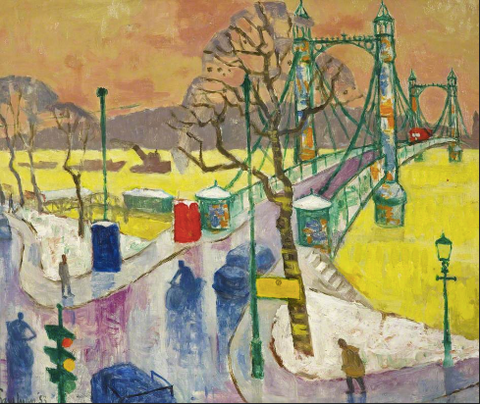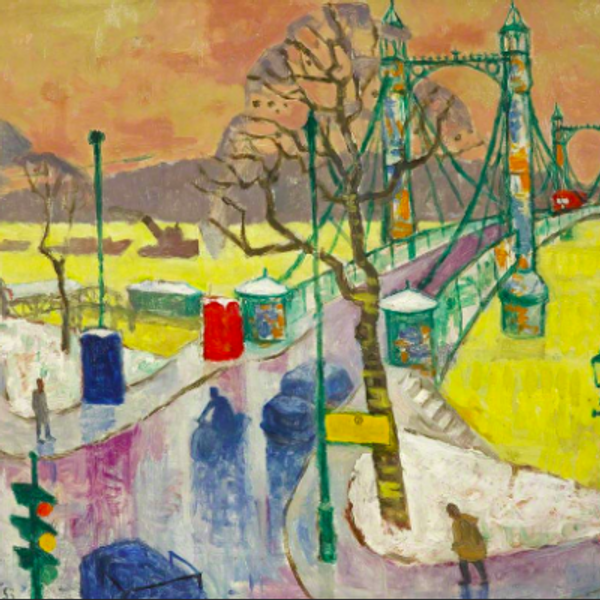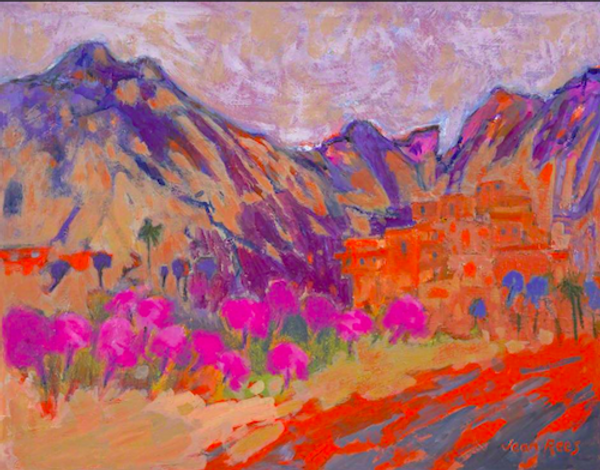Art Appreciation Series: Thea Bailey on Julian Trevelyan and Jean Rees

We asked our artists to share works from our Permanent Collection. Here, volunteer Thea Bailey chooses two of her favourites:
During our 2020 Lockdown the RWA invited Volunteers to blog about a painting in their Permanent Collection. So I’ve been looking at them all, goodness so many glorious ones to choose from, it was difficult to decide. But finally I choose two that both have strong vibrant colours and inviting forms, without being busy with action, and which I felt reflect aspects for what many of us have been experiencing during these challenging times, even though the two paintings are of such differing moods and location.
The first piece I’ve chosen is by Julian Trevelyan (1910-1988) who was married to the RWA’s third female President Mary Fedden, whose work I’ve always enjoyed. Trevelyan’s Albert Bridge - oil on canvas, 60 x 72.5 cm, a painting done in 1953 captivated me the first time I saw it, when it appeared in our 2018 Exhibition: In Relation. And it’s worth recalling that when he painted it, London was often still in the grips of thick peasouper fogs, famous for their dirty yellowish hue.
The first thing I fell in love with were the colours Trevelyan used for this famous London bridge scene, which many will know well, scenes gained through childhood and later when working in London. So perhaps that is why I was so drawn to this picture owing to their familiarity, rather important in a time when I am in Lockdown, and cannot venture out of Bristol. There’s a quality which feels as if it so well captures the spirit of our world since Coronavirus stopped all movement! Thus as a painting the empty state, doesn’t feel out of place, we’ve all experienced it now. A scene of relative stillness in our major city, without the busy traffic usually thundering over that bridge, and hordes of people milling about. What a mirror for our times, a reminder of the atmosphere of a city when it pauses and so reminiscent of an old fashioned quiet Sunday afternoon, that atmosphere has very much been with me during this period.
Clearly conveyed through his masterly use of paint, is a scene of a wet winter’s day, where the sky despite it’s pinky buff orange tones is depicted in a very watery way. And strikingly across the centre of the whole the mighty Thames flowing under the bridge, done in a strong lemon yellow that cannot but arrest the eye. A picture that has been set within a beautifully strong and simple light brown wooden frame which is part of the whole, creating a warm sympathetic harmony with the colours on the canvas. We are immediately drawn in to the central foreground by a splash of red of the traffic lights, and beyond stand two iconic symbols of a London long ago. The first, a blue police box on the corner of the cross-road, and then a red public phone as the Albert Bridge opens out to the centre of our view. While across the bridge, in the distance, a famous red London bus takes us further across the river to an unknown scene in tones of a mushroom haze, as iconic objects bring stability: a dredger boat and other river craft, the few street vehicles with figures in the foreground, giving a sense of movement, especially the figure on the right in his yellow mackintosh leaning into the wind under a yellow sign, and notice the taxi, a motorcyclist, the person on horseback and the delivery van. Then the great structure of the bridge itself, intricate ironwork so dominant and pronounced in wonderful almost racing greens, with exciting splashes of oranges and white all around – are we seeing snow or ice? – resonating with that dusky pink sky. Even the foreground tree is left to rather merge with the main supporting green arches of the bridge. And yet I feel uplifted by this painting, full of strong balanced colours and form. An incredibly atmospheric scene that feels so familiar to me.
I truly sense Trevelyan loving the scene and the colours he used to capture it in his distinct style; so different to what many might have chosen. But that is what is wonderful about his work, the choices of his colours and his forms, the delineated outlines given to objects or not. I am reminded of Les Fauves artists and their shockingly brave choices of colour at the time, painting I’ve also always loved. The early 50s was a time when people where beginning to wake from war-time utilitarian grey, art was returning to greater prominence away from the horrors of war damage,
renewal was present, British people were emerging with a need for new colour and form. And here we are once again today, longing to emerge from Lockdown, longing to travel with ease, and once more, longing to enjoy our freedom.
The second painting I’ve chosen is by Jean Rees (1914-2004), mother of Jeremy Rees who with his wife Annabel founded the The Arnolfini Gallery in the early 60s. (A place where under this lovely man, I was lucky enough to work as a Volunteer.) Jean Rees was an established painter, but very much dedicated the later years of her life to supporting and promoting the visual arts, particularly in the West of England.
Almond Blossoms and a Village, (no date) oil on board 56 x72 cm, is not a painting I’d seen before, but captured my attention. Just as her Gower Coast painting, full of deep blues (also in this collection) had done. Her strong colours and celebration of a scene immediately touched me, and like Julian Trevelyan's painting is to me a picture done by someone really enjoying what they were seeing. Knowing that a group of her landscape paintings were done in Crete, perhaps this too was created there. It certainly feels as if it emerged from that part of the world, with it’s hills and earthy oranges, and a high sky. The first colour to hit me was the striking left foreground of really icing sugar pinks of Almond blossom, just like the blossoms I’ve been enjoying in these last few magical weeks, it’s like an echo, and a delight.
During my daily walks – essential in maintaining my equilibrium – through March’s Lockdown, it seemed as if I were under a constantly clear blue sky, without the contrails from planes, and the freshness in the air creating a stillness of delicate light, within a remarkable peace. And just as all the exquisite blossoms of Spring were emerging day by day, and new fresh green leaves burst out, shimmering in the shift of light to the accompaniment of wondrous birdsong, here in Jean’s lovely picture, the same intensity of light seems to have been captured. In her shift from the rich sharp pinks of Almond blossoms of the foreground a lone palm tree in dark green stands just behind giving depth, drawing the eye across to the splashes of strong blues singing in front of the rich oranges of squared house forms of the village, nestled into the foot of the great mountain heights dominating the background. The use of mud earth colours takes the eye to the hillsides filled with purple and mauves, buffed out with pale neutral tones, so that the white of the sky, that seems to sit so high, creates a wonderful calm over these rich vibrant colours. To me the depth of bold colours evokes those mediterranean scenes, and the contrasts of terracotta hues appear drenched by strong sunlight in that dry landscape. Somehow those purples and ochres are given balance from that white above, it appears to promote the blossoms and tight village forms.
What a joyous painting, with it’s rich complexity of tones, it transported me there, to that other country. I could feel how this vista must have inspired Jean, with the stillness so often experienced in great heat. There is no action, which in a strange way feels close to what we’ve all had to face with Covid-19. And I for one, cannot wait to be able to walk and travel again with ease to these inspiring landscapes… Art is so brilliant at nourishing us on so many levels, transforming our awareness and taking us on a glorious journey.
Gallery

